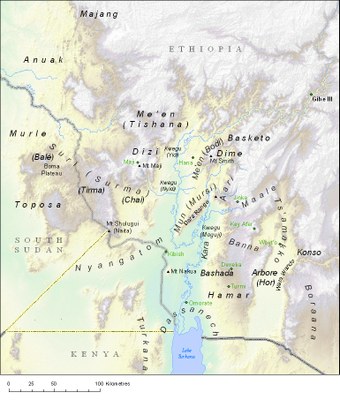Neighbours
The Lower Omo Valley is inhabited by several small groups, a few thousand strong, who speak languages belonging to three major African language families: Nilo-Saharan (Mursi, Chai, Tirma, Balé, Me’en, Nyangatom and Kwegu (or Koegu)), Omotic (Aari, Kara, Banna, Bashada and Hamar) and Cushitic (Dassanetch). The closest linguistic and cultural links of the Mursi are with the Chai and Tirma, who live west of the Omo and south of Maji. The Chai and Tirma together number about 28,000. They and the Balé have a joint self-name, Suri, and are known as Surma in the nearby highlands. The Mursi, Chai and Tirma speak the same Surmic language with differences of dialect only, and intermarriage between Mursi and Chai is common. The Me’en consist of seven territorial groups, two of which, Mela and Chirim, live east of the Omo. These two groups are together called ‘Tumura’ by the Mursi and ‘Bodi’ by government officials and other outsiders. The Mursi call the Aari and Dizzi ‘Su’, the Kara ‘Kera’, the Hamar ‘Hamari’, the Nyangatom ‘Bume’ and the Dassanech ‘Geleba’. They have peaceful relations with the Chai, and intermittently hostile ones with the Bodi and Nyangatom, with whom they do not intermarry.
The Kara and Kwegu number no more than a few hundred respectively. The Kara speak the same language as the Hamar and live south of the Omo-Mago junction. The Kwegu also live along the Omo, amongst the Bodi, Mursi and Kara. The Kwegu are called ‘Nydi’ (sg. ‘Nyidini’) by the Mursi and ‘Muguji’ by Kara and Hamar). Although their language belongs to the Nilo-Saharan family, it is not mutually intelligible with Mursi, Bodi or Nyangatom.
More information
A comprehensive list of anthropologists and others who have worked amongst the peoples of the lower Omo, and more widely in southern Ethiopia, may be found on the website of the South Omo Research Center.


